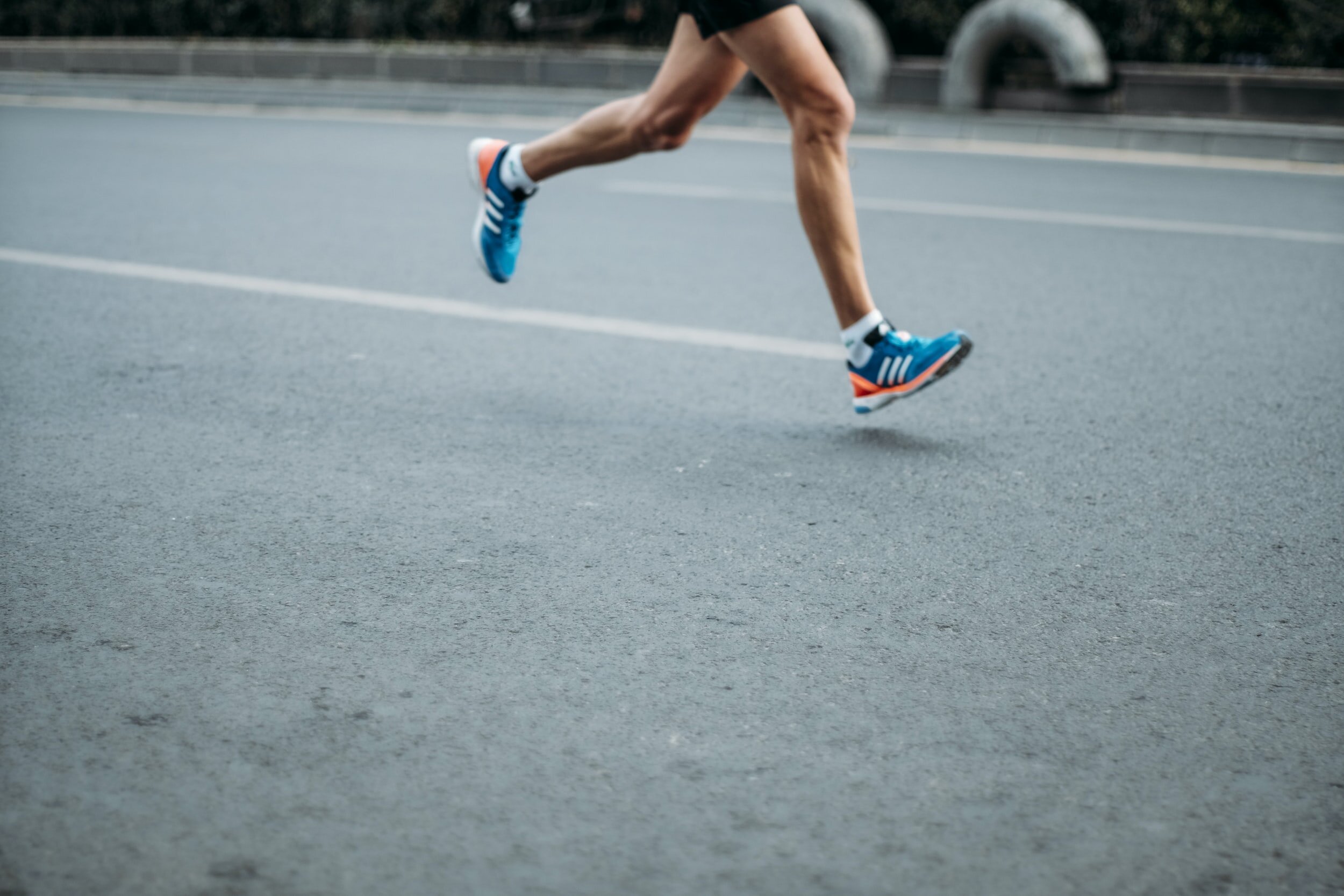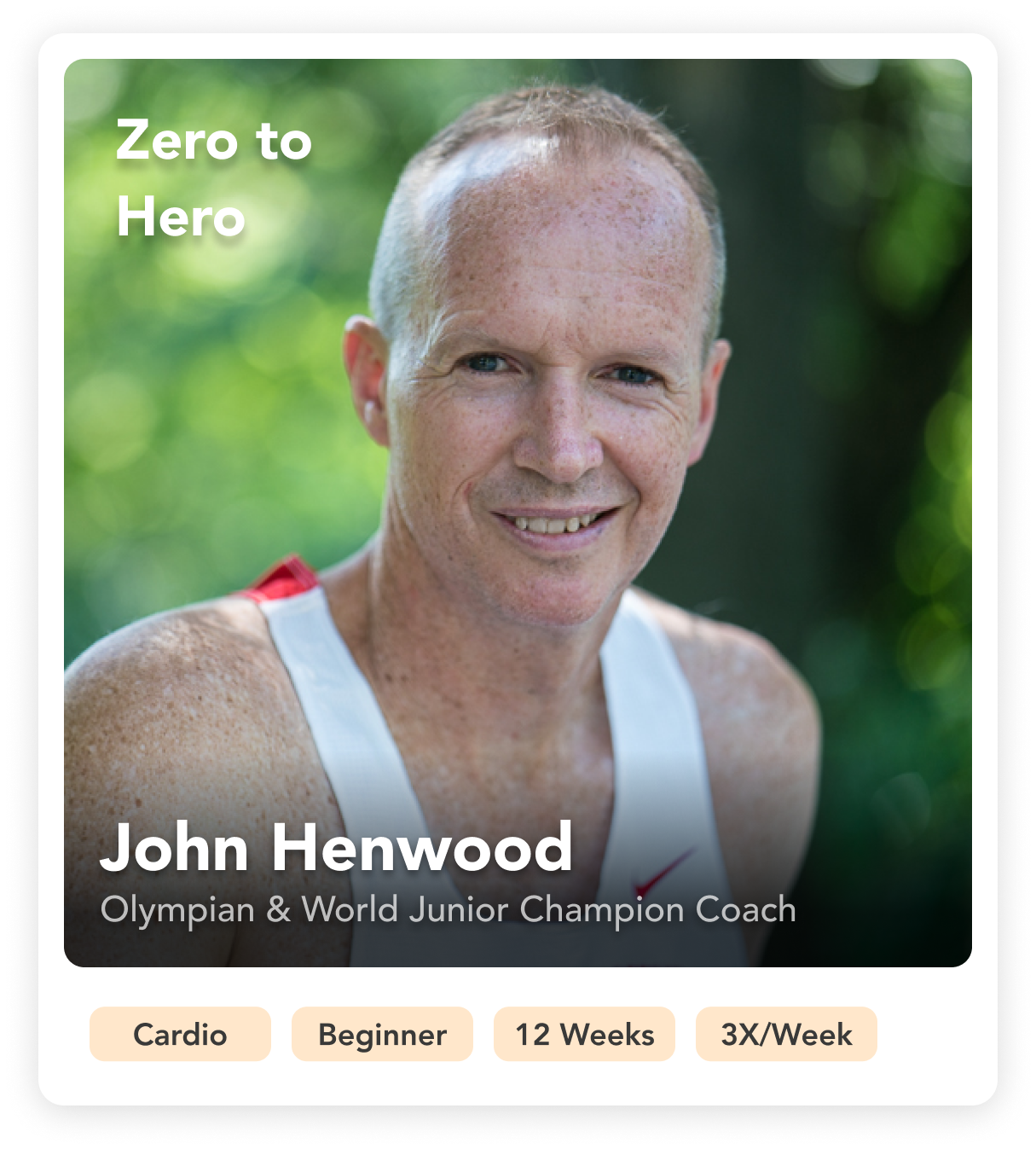
Zero to Hero
with John Henwood
Cardio. Running.
About Zero to Hero
Zero to Hero is for the true beginner who has very little experience in running or cardiovascular training. If you have not participated in cardio training for over 1 year and you don’t think you can run more than 1 mile without stopping, this program is for you.
Why this program?
By the end of the Zero to Hero program, you will be able to:
Run 60 minutes with relative ease and without rest
Dramatically improve your cardiovascular fitness
Feel better every day
Skills You’ll Gain
Cardio, running.
Who is this program for?
This program is designed for people the true beginner with little to no experience in running or cardiovascular training.
About John Henwood
Olympian, Running Coach, and Strength Trainer
Olympian John Henwood is a running coach and strength trainer in New York City. He is now the coach of previous World Junior Champion Mary Cain. John has coached Jane Vongvorachoti on her road to represent Thailand in the 2016 Olympic Games.
Most of the time, John is coaching beginner runners and intermediate or sub-elite runners to run a best time or a qualifying time for a particular race. As well as looking after his own running team (Henwood’s Hounds Racing Team), John works with Mile High Run Club and is in charge of their outdoor Half Marathon and Marathon Programs.
FAQ
Program
What is the difference between the two programs listed?
The Complete Beginners program is designed for people the true beginner with little to no experience in running or cardiovascular training. The Detrained Athletes program is for people who have run long distances at some point in their lives, but it has been a substantial amount of time since their last long distance run.
How many workouts should I do each week?
If you want to follow a schedule, it is recommended to do 4 workouts each week for these programs. But the most important thing is to listen to your body; if you need more rest, take it.
Can these programs be done on a treadmill or should it be done outdoors?
It can be done on either, or both if you prefer. Both programs are meant to get you acquainted to running, and that could mean either indoors or outdoors. If you want to simulate the outdoors on the treadmill, run at a 1% incline.
What is the progression like?
In the first 8 workouts, the workouts are around 20-30 minutes long. This will help your body adapt to running so you don't get hurt. The running interval time will gradually increase, throughout the program and the walk/recovery time will decrease. By the end of the program you will be able to run a full hour non-stop!
The progression is too hard, I’m having trouble keeping up. What should I do?
If you are having problems getting through a run, don’t fear it. Just slow down or walk until you’re ready to run again. You’re going too fast! You can also redo the last workout you completed until you’re ready to try the next one again.
When can I expect to lose weight with these programs?
Fundamentally, weight loss is based on calories in vs. calories out. If your diet stays the same (calories in), and you start working out (calories out), you can expect to see results in fat weight in 2-4 weeks. Remember you’ll be gaining some muscle at the same time from underused muscles. So a better clothing fit is a better measure than overall weight loss.
How fast should I run?
Run at an easy pace comfortable to you. Listen to your body. Since you are just starting out, it’s important to get comfortable running without aiming for specific speed goals. Over time, we can work on increasing speed but having strong endurance is the most important foundation for beginner runners.
Running
I want to start running, what do I need?
Only a pair of running shoes (fitted at a running store) and suitable clothing. Invest in comfort. Ensure that your clothing is breathable and light in the summer, and holds warmth in the winter.
What is a good running form?
Body
You should run tall. Shoulders back, chest out, hips forward. The slight lean forward comes from your ankles, not your waist. Have your hands cupped, as if you were holding onto an egg. Not clenched or fingers out straight.
Breathing
Inhale and exhale through the mouth when running. Your nose only comes into play with your mouth, as you breathe heavier.
When should I stretch?
You should do dynamic stretches before a run and static stretches after a run for at least 5 minutes. This will help with injury prevention, and help you train better the next day.
Soreness & Injuries
I’m feeling a little sore, should I just “push through it”?
Train smart. Don’t ever run two HARD days in a row. When there’s two days in a row in the program, take the first day easier. Prepare for the second day. If you’re still sore, try a deep tissue massage, foam roll or more stretching. If you are sick or have a cold, do not run. If you do, you may turn a 1-3 day cold into 2 weeks. Let your body fight it. Once over the cold rewind the training back a week or so and start from that point. The more training you lose, the more you have to rewind back.
Will I be sore after my workout?
If this is your first time running, or you haven’t ran in a while, yes you will likely be a bit sore after your workout. This is because you are working out muscles which you haven’t used in that way for a while. Don’t worry, this is normal. Your muscles have to adapt to the new stress. It won’t take long for that to happen. Just remember to stretch before and after the workout to help relieve sore muscles.
My skin hurts from chafing - is this normal?
Yes this is normal for runners. Chafing is caused by several factors: loose clothing, non-breathable fabric, hot and humid weather, and body weight. To help with chafing on either the nipples, thighs, or blisters on your feet, try Vaseline!
My foot is sore, what can I do?
Pain under the foot can commonly be related to a Plantar issue. Try to loosen the calf muscles with deep tissue massages and stretches. If the pain persists, seek out a physical therapist to help. If you get sore across the top of the foot, it can be because your shoelaces are too tight, your shoes are gone over 300-400 miles (need new shoes) or you may not be landing correctly and need some kind of orthotic. Visit a running store for more advice.
Diet
Should I change how I’m eating while on the program?
Try to eat more of the right foods so your body can use them to fuel your workouts. Do not starve yourself if you are trying to get leaner, just eat more healthier foods and cut down on some of the junk foods and soda. Yes! Even diet soda! Try and become a grasier where you eat 5x per day (3 meals and 2 snacks) to keep your metabolism up. That means not overeating in meals. If you eat only a couple of times per day, you need to change that if you want to lose weight and keep it off.
Should I be eating more carbs while on the program?
Eating more of the right foods like low glycemic carbs to replace some of the junk food is advisable. It is not necessary to “carbo-load” before a short run. This is usually done for long races to ensure enough energy (glycogen) is there to sustain you through the run.
Should I eat before a run?
Most runs under 60 minutes don’t require a snack or food before the run. But everyone is different. If you feel you can’t run well without something in your stomach, have something like a banana or other light snack 60-90 mins before the run. Have the rest of a meal or snack within 30 mins of finishing the run if possible.

